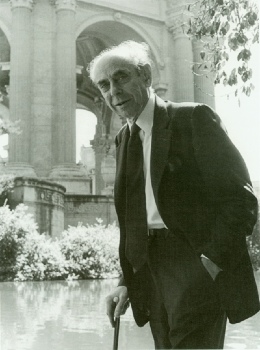| The Aesthetic of Frank Oppenheimer | |||||
| Linda Dackman, Exploratorium Published in Museum Magazine and Leonardo | |||||
| Who is Frank Oppenheimer and what does he know about aesthetics? Oppenheimer is a physicist, an educator, and founder and director of the Exploratorium. He says he only knows "if something feels good or not," but that apparently simple bit of homespun philosophy is but a thimble-full of an aesthetic that has had a worldwide impact on museum conception and design. Oppenheimer's name is virtually synonymous with 'hands-on' and 'participatory' learning, a name (along with that of the Exploratorium), which resonates in existing and planned institutions as far flung as Argentina's proposed Escuela Del Sol, China's Shangai Science Center and Beijing's Science and Technology Museum; London's Science museum; Paris' Parc de La Villete; Hong Kong's Museum of Science and Technology, and Venezuela's Museo de Los Ninos, to name only a handful. The application of Oppenheimer's aesthetic of "how things feel" to the process of exhibit conception and design is well known. But it is too narrow an application. In an afternoon of conversation, excerpted here, Oppenheimer's freely associated thoughts and his anecdotes, reveal other areas within the creation and operation of a museum (not to mention such diverse topics as vacuum cleaners and cattle ranching) to which the aesthetic of "how things feel" might apply. The Exploratorium started with the idea that science and one's world is understandable. It introduces people to science through perception -- how one sees and hears and feels. Perception is the basis for what we find out about the world and how we interpret it -- whether we do so directly with our eyes or |  | ||||
| develop tools, such as microscopes or accelerators -- to help us. Perception is also the basis for art and poetry and literature. So perception makes a very good beginning for a place that seeks to put everything together for its visitors. The Exploratorium looks at nature from the point of view of the scientist and the artist. It demonstrates the workings and connections in nature and communicates these on the level of human experience. There is a visible beauty, form and structure to the natural world that the Exploratorium describes. The underlying aesthetic principles of the Exploratorium, however, are somewhat less visible. They have less to do with what | |||||